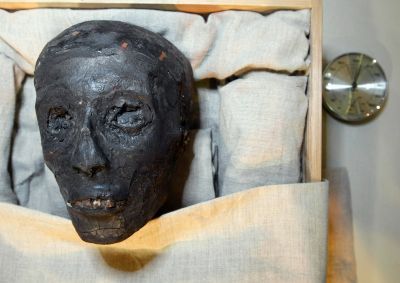King Tut likely had club foot, killed by malaria: study

Your support helps us to tell the story
From reproductive rights to climate change to Big Tech, The Independent is on the ground when the story is developing. Whether it's investigating the financials of Elon Musk's pro-Trump PAC or producing our latest documentary, 'The A Word', which shines a light on the American women fighting for reproductive rights, we know how important it is to parse out the facts from the messaging.
At such a critical moment in US history, we need reporters on the ground. Your donation allows us to keep sending journalists to speak to both sides of the story.
The Independent is trusted by Americans across the entire political spectrum. And unlike many other quality news outlets, we choose not to lock Americans out of our reporting and analysis with paywalls. We believe quality journalism should be available to everyone, paid for by those who can afford it.
Your support makes all the difference.The celebrated pharaoh Tutankhamun had a club foot, walked with a cane and was killed by malaria, a study that harnessed modern genetic testing and computer technology to lift a veil on the secrets of ancient Egypt showed Tuesday.
Researchers from Egypt, Italy and Germany used DNA testing to draw "the most plausible" family tree to date for Tutankhamun and computerized tomography (CT) scans to determine that the pharaoh and his forebears were unlikely to have had the feminine physiques they are depicted with in 3,000-year-old artifacts.
They analyzed DNA taken from 11 mummies, including the boy king himself, and scanned all but one of the mummies to determine if they were related, look for evidence of genetic disorders and infectious diseases, and determine what killed Tutankhamun at the age of 19.
Tutankhamum - who is often referred to as King Tut - died just nine years into his reign, which lasted from 1333-1324 BC.
"Many scholars have hypothesized that Tutankhamun's death was attributable to an accident, such as a fall from his chariot or a kick by a horse or other animal; septicemia or fat embolism secondary to a femur fracture; murder by a blow to the back of the head; or poisoning," the study said.
But genetic testing found evidence that Tutankhamun had been infected with plasmodium falciparum, the parasite that causes an often deadly form of malaria.
The scans and genetic fingerprinting carried out on Tutankhamun also showed he had several disorders, some of which ran in the family. They included a bone disease and a club foot.
So rather than the majestic ruler that Tut is often depicted as, the pharaoh was probably "a young but frail king who needed canes to walk because of the bone-necrotic and sometimes painful Koehler disease II, plus oligodactyly (hypophalangism) in the right foot and clubfoot on the left," the study said.
Tut's many disorders probably weakened his immune system over time, and the researchers believe he might have died when, in his immuno-deficient state, he sustained a "sudden leg fracture, possibly introduced by a fall," which snowballed into a life-threatening condition when he contracted malaria.
Using genetic fingerprinting, the researchers also lifted the veil on another mystery surrounding King Tut: his lineage.
Using partial Y-chromosome information, the researchers determined that Akhenaten, the controversial pharaoh who ruled from around 1351-1334 BC and tried to radically transform religion in ancient Egypt, was Tut's father, and that Tutankhamun's mother was Akhenaten's sister.
Tut also sired two children, both girls, but they died in the womb, the study found.
But the researchers, led by Zahi Hawass of the Supreme Council of Antiquities in Cairo, found no evidence that Tutankhamun and his father had feminine physiques as depicted in artifacts from the era.
"It is unlikely that either Tutankhamun or Akhenaten actually displayed a significantly bizarre or feminine physique," the study said, noting that "ancient Egyptian kings typically had themselves and their families represented in an idealized fashion."
The study represents another step in blending science and history into "molecular genealogy" and "pathogen paleogenomics of the Pharaonic era," the authors said.
But it also raises ethical questions, in particular about when it is right to disturb the dead for a scientific study or examination, said Howard Markel of the University of Michigan in an editorial accompanying the study.
Tutankhamun's "brief reign, youthful visage, and premature death, as well as the rediscovery of his remains and tomb in 1922 (by British archaeologist Howard Carter), have fascinated Egyptologists and other historians alike for decades," Markel wrote.
"But we have to take into account the respect that most societies have for their dead before we disturb the deceased with the wonders of 21st-century science," Markel told AFP.
Among cases where "paleo-pathology" would be justified are when a study "might improve health or might change our perception of a historical era, which I think this study does," Markel said, adding that the study into Tutankhamun was conducted "with meticulous attention and respect for the dead."
Join our commenting forum
Join thought-provoking conversations, follow other Independent readers and see their replies
Comments